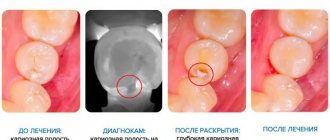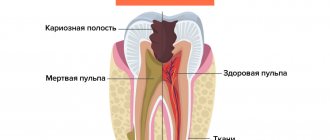Conservative method of treating pulpitis
The simplest option used by dentists for patients suffering from focal, acute and fibrous infections. It consists of carrying out a certain list of fairly easy and quick procedures:
- Anesthesia using local anesthetic drugs.
- Removing affected tissue using, for example, a drill.
- Treatment of the oral cavity with any specialized antiseptics.
- Applying an insulating pad.
- Installation of a temporary filling product.
The result of such operations is a whole range of positive aspects. The patient's severe inflammation is relieved, metabolic processes are restored, dentin regeneration begins, and so on.
Pulpitis of the tooth and its treatment
A characteristic sign of this pathology is inflammation in the pulp, which is located inside the tooth cavity, where blood vessels and nerves are concentrated. The cause of inflammation is the penetration of harmful bacteria into the cavity due to damage to the external dental tissues (enamel and dentin). This is the destruction that we most often owe to untimely treatment of deep dental caries: pulpitis becomes a consequence of the carious process. Much less often, it appears due to mechanical damage to the pulp, poor preparation of the tooth for filling, and unprofessional installation of orthopedic structures.
Treatment methods for pulpitis
In dentistry, two main methods are used to treat dental pulpitis in adults and children:
- biological - drug treatment of pulpitis with antibiotics and medications;
- surgical - treatment of pulpitis by amputation (partial removal of the pulp) or extirpation (in which the nerve of the tooth is completely removed).
The choice of technique remains with the dentist. The doctor studies X-ray diagnostic data, interviews and examines the patient. Based on these data, he selects the most rational method of treating pulpitis for a particular case.
Biological method of treating pulpitis
If the disease has become chronic, a biological method or conservative treatment of pulpitis with calcium is used. The process involves applying therapeutic pads containing calcium preparations. The technique is also used in the following cases:
- if the pulp was accidentally exposed during the caries treatment procedure;
- when you need to strengthen the bone partition between tooth enamel and pulp.
The specialist applies a drug for the treatment of pulpitis to the site of thinning bone tissue and thereby strengthens it. Next, the tooth is filled and monitored over time, conducting X-ray examinations at certain time intervals. The method is suitable:
- children with baby teeth;
- patients under 30 years of age during the treatment of reversible pulpitis;
- everyone who takes special care of their oral cavity.
If, after treatment of pulpitis, the tooth aches, hurts when pressed or bitten, and the pain remains for a long time, intensifies at night, and becomes long-lasting, you must return to the clinic. Aching pain during the treatment of pulpitis indicates that more radical, that is, surgical, methods are needed.
What is pulpitis: how does the disease appear, what signs may indicate its development?
The pulp, or dental nerve, is located inside the tooth and is protected by its crown (the hard outer part). But if a person does not treat caries, then gradually pathogenic bacteria will destroy the tooth and this process will reach the pulp. As soon as the infection penetrates the sensitive nerve bundle, the inflammatory process begins. Strong throbbing pains that usually appear at night can tell you about inflammation of the nerve. The strength of these pains can be so great that they do not go away even when taking strong painkillers from the pharmacy.
USEFUL TO KNOW: Of course, pulpitis can appear for a number of other reasons. For example, due to poor quality treatment of caries, improper treatment of dental canals, severe colds with complications. But most often the cause of pulpitis is advanced caries!
Watch a short video about the treatment of pulpitis
But acute pain due to pulpitis appears already with sufficient development of inflammation. In the initial phase, pain may occur when a diseased tooth comes into contact with cold or, conversely, too hot food, sweet or sour food. If you have such signs, be sure to make an appointment with a doctor, because in the initial phases of the disease, pulpitis can be treated quickly and using gentle methods!
USEFUL TO KNOW: At the initial stage of development of the inflammatory process in the pulp, pain in the tooth can be suppressed with analgesics. And many patients do this, believing that they have cured the tooth on their own. This is a very dangerous misconception, since taking painkillers does not eliminate inflammation, but simply removes its external signs. Inflammation will develop and can affect not only the entire dental nerve, but also spread to the root of the tooth. Under such circumstances, it will be impossible to save the tooth!
You should not rejoice prematurely even if the pain in your tooth subsides on its own. This may indicate that the dental nerve has died and the inflammation has turned purulent. In such cases, flux usually appears in the area of the diseased tooth.
Therefore, if you suspect you have tooth pulpitis, do not delay its treatment, contact the dentist immediately. Our clinic in Moscow, Aesthetica, uses modern and effective methods for treating pulpitis, allowing you to save the tooth even in the most advanced cases!
Take a short test and calculate the cost of treatment!
Take a short test
- Jaw selection
- Availability of photo
- Selecting a brace system
- Date of treatment
- Cost calculation
×
Manukyan Artavazd Genrikovich
Chief physician of the clinic
How is pulpitis treated surgically?
As we have already noted, there are two possible options for surgical intervention:
- treatment of pulpitis using the amputation method with partial preservation of the pulp;
- treatment with complete removal of soft tissues, blood vessels, and nerves.
If there is an objective possibility, the doctor will remove only the top of the pulp - from the crown, leaving the root part. The blood supply and sensitivity (innervation) of the tooth will be preserved. The technique is used in the treatment of children - for milk or permanent teeth that have not yet fully grown. This allows them to form normally in the future. Treatment for pulpitis can be carried out in one visit.
Why is it necessary to remove a nerve?
Removal of the dental nerve is required in advanced inflammatory processes that affect both soft and hard tissue structures, including the pulp.
The most common reasons:
- periodontitis,
- pulpitis,
- benign neoplasm near the root,
- deep pulpal caries.
Depending on the type of pathological process and the size of the affected area, removal is carried out with partial preservation of the pulp or complete preservation from all canals. Amputation of part of the nerve is usually used for dental caries. In other cases, complete removal is usually necessary.
Treatment of acute pulpitis
The above methods are ineffective in treating exacerbations of chronic pulpitis, an acute disease when the tooth becomes a source of unbearable pain radiating to the ear, temple, and back of the head. With these symptoms, endodontic treatment of pulpitis is carried out - with cleaning of the root canals and complete removal of the pulp.
In dentistry, two modern methods of treating tooth canals for pulpitis are used: devital and vital.
- Treatment of pulpitis using the vital amputation method is carried out by removing the nerve, washing, cleaning and filling the canal.
- Devital treatment of pulpitis involves the use of medicinal pastes and requires several sessions.
These treatment methods are most often used for pulpitis on permanent teeth.
How long does pulp removal take?
On average, it takes about 40-50 minutes for pain relief, nerve removal, and root canal treatment. If the doctor administers high-quality anesthesia, it will take effect almost immediately, and the patient will not feel pain throughout the entire process. If the effect of anesthesia weakens during depulpation, an additional injection is given.
Reference! Before administering an injection with anesthesia, the doctor treats the soft tissue with a special freezing agent. That is, the patient will not experience pain either when inserting a needle into the tissue or during the process of removing the dental nerve.
Stages and stages of tooth treatment for pulpitis using the devital method
- Stage I.
The tooth is anesthetized and the carious cavity is cleaned. The pulp cavity is opened. - Stage II.
A devitalizing paste is placed into the exposed pulp and the tooth is filled for 3 to 7 days. People still call the paste “arsenic,” although it has nothing to do with this substance. - Stage III.
During your next visit, your dentist will clean the root canals according to medical protocol. - Stage IV.
If there is a risk that the tooth will crack, it is covered with a crown. If the hard tissues are well preserved or only slightly damaged, they are restored. The tooth is strengthened with a fiberglass or metal anchor pin and securely filled with photopolymer material.
The treatment time for pulpitis depends on how damaged the tooth is, the age of the patient, whether there are complications, and how many root canals should be treated.
Is it painful to treat pulpitis?
Many patients believe that treatment for pulpitis is painful. In fact, pain accompanies the disease itself, and not the procedure for its treatment. The pulp tissue and nerves become inflamed, which causes unbearable painful sensations comparable to an electric shock. Pulp removal is absolutely comfortable, because high-quality anesthetics completely relieve the patient of pain while the doctor prepares the canals. During treatment or after treatment of pulpitis, the tooth hurts when the internal tissues are severely inflamed. Then safe painkillers are prescribed while healing occurs (1 - 3 days).
Feel
After full anesthesia, dental treatment and accompanying manipulations are absolutely painless. The patient does not even notice the nerve removal procedure. Some patients experience discomfort as the anesthesia wears off. There may be increased tooth sensitivity when biting. This is a normal reaction to canal work, does not cause much discomfort, and usually goes away after a few days. Taking painkillers eliminates these sensations.
Be healthy!
The information was prepared by dentist Smirnov E.S.
Possible complications
If you delay visiting the dentist, inflammation can spread to the bone tissue of the tooth - periodontium. This is how one of the most common and dangerous complications of this disease begins - periodontitis, which can lead to tooth extraction. Periodontitis also occurs due to an unskilled approach to cleaning root canals.
If you are concerned about an elevated temperature after treatment for pulpitis, urgently contact a more reputable dentist, as the inflammation is progressing. Professional clinics use modern methods of canal treatment using microscopes, binoculars, visiographs, endomotors, and apex locators. These instruments prevent the risk of complications.
Unfortunately, pulpitis remains a common occurrence after caries treatment. The reason for its appearance is the same - the unprofessional actions of a doctor who violated medical protocols and made mistakes when filling. Perhaps he accidentally opened the pulp and gave bacteria access to it.
How much does tooth treatment for pulpitis cost?
The final cost of pulpitis treatment is influenced by many factors: the degree of destruction of hard tissue, the number of canals in the tooth, the presence of complications, concomitant diseases, and the chosen treatment method. If the tooth is permanent and has one canal, then the procedure in Moscow clinics will cost from 5,000 rubles. This amount includes a full range of services: x-ray diagnostics, application of anesthetic, installation of a rubber dam, treatment of caries, treatment of dental canals with cleaning, installation of a filling. Price may change if multiple sessions are required.









